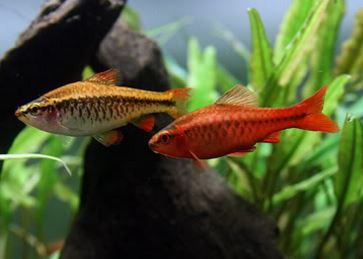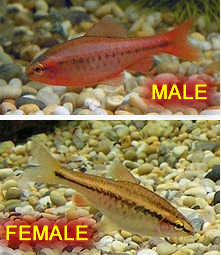
-

Cherry Barb Male & Female Cherry Barbs make fantastic aquarium subjects for their colour, hardiness, tolerance of varied water conditions and peaceful nature when kept in schools of 6 or more.
Common Name(s) : Cherry Barb
Family : Cyprinidae
Genus: Puntius
Species : Puntius titteya
Origin : Sri Lanka
PH : 6.5 – 7.5
Hardness : Soft to Hard
Temperature : 18 – 28°C / 64–82°F
Maximum Size : 5cm / 2 inches
Lifespan : 5 years
Aggression Level : Low-Medium (3.5/10)
Recommended Tank Size : 30 Litres +
Strata : Bottom Half
DESCRIPTION
The Cherry Barb is an elongated fish with a relatively compressed body. It reaches 5 cm or pproximately 2 inches in length.
It is fawn-coloured on top with a slight greenish sheen. Its sides and belly have gleaming silver highlights. A horizontal stripe extends from the tip of the snout through the eye to the base of the caudal fin.
The male is more of a deeper red than the female, becoming very deep red in color when breeding. The dominant male often has the darker colours a down the sides as the females have two pinkish colour stripes down their sides also becoming darker when ready to breed.
TANK SET UP
Provide rocks, large pieces of driftwood, live or fake plants etc for lots of cover
SUITABLE TANK MATES
- Angelfish
- Dwarf Cichlids
- Bristlenose
- Corydoras
- Danios
- Siamese Flying Fox
- Loaches
- Mollies
- Platys
- Rainbows
- Rasboras
- Sharks
- Silver Dollars
- Snails
- Swordtails
- Tetras
DIET
Omnivores – Frozen, Live, Flakes, Pellets, Vegetables
SEXING AND BREEDING
Male Cherry Barbs are generally slender in shape and more brightly coloured than females – particularly whilst breeding they tend to go an even brighter red colour. Females are also recognized by their fuller abdomen particularly when in spawning condition.
Barbs will readily breed in an aquarium. To successfully breed Cherry Barbs you might like to set up a separate densely planted tank and after the eggs have been scattered (usually 200 to 300 of them!!) the adults should be removed as Barbs have a tendency to eat their own eggs.
During breeding, a male will swim just behind the female, chasing away rival males. The female will spawn the eggs and scatter them on plants and on the substrate. The eggs will hatch in one to two days and the fry are free-swimming after two more days. After five weeks, the fry will be about 1 cm long and easily identifiable as cherry barbs.
